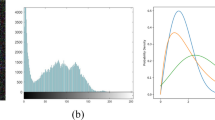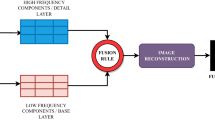Abstract
Denoising is an integral step in the automated analysis of Magnetic Resonance (MR) images. A computationally fast restoration algorithm with a minimum number of operational parameters and appreciably good edge-preserving characteristics is missing in the literature. To fill these gaps, an edge-preserving filter based on the principles of iterative diffusion and Beltrami flow is introduced in this paper. The value of the restored intensity at an arbitrary location during current iteration is a sum of two distinct terms. First term is the cumulative sum of flow values corresponding to its 8-connected neighbours, scaled by an arbitrary normalization constant. The second term is the restored intensity corresponding to that pixel computed in the previous iteration. The optimum value of the number iterations in the algorithm is determined with the help of a newly designed Target Function (TF). The TF is the absolute difference between Relative Statistics of Noise (RSN) and Relative Strength of Dominant Edges (RSDE). The proposed target function has shown good concordance with the subjective quality of output images at different values of the number of iterations. The proposed Optimized Beltrami Flow-based Iterative Diffusion filter (OBFID) is found to be superior to other filters in terms of the ability to preserve the edge strength and suppress noise. It is computationally fast compared to other filters.









Similar content being viewed by others
Data Availability Statement
This manuscript has associated data in a data repository. [Authors’ comment: All data included in this manuscript are available upon request by contacting the corresponding author.]
Code availability
Code can be made available on request.
References
A. Chincarini, P. Bosco, G. Gemme et al., Alzheimer’s disease markers from structural MRI and FDG-PET brain images. Eur. Phys. J. Plus 127, 135 (2012). https://doi.org/10.1140/epjp/i2012-12135-6
S.D. Bruno, M. Cercignani, C.A.M. Wheeler-Kingshott, Neurodegenerative dementias: From MR Physics lab to assessment room. Eur. Phys. J. Plus 127, 139 (2012). https://doi.org/10.1140/epjp/i2012-12139-2
M. Irshad, N. Muhammad, M. Sharif et al., Automatic segmentation of the left ventricle in a cardiac MR short axis image using blind morphological operation. Eur. Phys. J. Plus 133, 148 (2018). https://doi.org/10.1140/epjp/i2018-11941-0
V.R. Simi, D.R. Edla, J. Joseph, An inverse mathematical technique for improving the sharpness of magnetic resonance images. J. Ambient. Intell. Humaniz. Comput. (2021). https://doi.org/10.1007/s12652-021-03416-1
A.M. Wink, J.B.T.M. Roerdink, Denoising functional MR images: a comparison of wavelet denoising and Gaussian smoothing. IEEE Trans. Med. Imaging 23(3), 374–387 (2004). https://doi.org/10.1109/TMI.2004.824234
O.L. Usman, R.C. Muniyandi, K. Omar, M. Mohamad, Gaussian smoothing and modified histogram normalization methods to improve neural-biomarker interpretations for dyslexia classification mechanism. PLoS ONE 16(2), e0245579 (2021). https://doi.org/10.1371/journal.pone.0245579
G. Hamarneh, J. Hradsky, Bilateral filtering of diffusion tensor magnetic resonance images. IEEE Trans. Image Process. 16(10), 2463–2475 (2007)
S.A. Akar, Determination of optimal parameters for bilateral filter in brain MR image denoising. Appl. Soft Comput. 43, 87–96 (2016)
E. Yahaghi, M. Mirzapour, A. Movafeghi et al., Interlaced bilateral filtering and wavelet thresholding for flaw detection in the radiography of weldments. Eur. Phys. J. Plus 135, 42 (2020). https://doi.org/10.1140/epjp/s13360-020-00119-y
P. Coupe, P. Yger, S. Prima, P. Hellier, C. Kervrann, C. Barillot, An optimized blockwise nonlocal means denoising filter for 3-D magnetic resonance images. IEEE Trans. Med. Imaging 27(4), 425–441 (2008)
Y. Gal, A.J.H. Mehnert, A.P. Bradley, K. McMahon, D. Kennedy, S. Crozier, Denoising of dynamic contrast-enhanced MR images using dynamic nonlocal means. IEEE Trans. Med. Imaging 29(2), 302–310 (2010)
H.V. Bhujle, B.H. Vadavadagi, NLM based magnetic resonance image denoising – A review. Biomed. Signal Process. Control 47, 252–261 (2019)
A. Movafeghi, M. Mirzapour, E. Yahaghi, Using nonlocal operators for measuring dimensions of defects in radiograph of welded objects. Eur. Phys. J. Plus 136, 655 (2021). https://doi.org/10.1140/epjp/s13360-021-01652-0
K. Krissian, S. Aja-Fernandez, Noise-driven anisotropic diffusion filtering of MRI. IEEE Trans. Image Process. 18(10), 2265–2274 (2009)
G. Gerig, O. Kubler, R. Kikinis, F.A. Jolesz, Nonlinear anisotropic filtering of MRI data. IEEE Trans. Med. Imaging 11(2), 221–232 (1992)
C. Tong, Y. Sun, N. Payet, S.H. Ong, A general strategy for anisotropic diffusion in MR image denoising and enhancement. Magn. Reson. Imaging 30(10), 1381–1393 (2012)
L.B. Montefusco, D. Lazzaro, An iterative L1-based image restoration algorithm with an adaptive parameter estimation. IEEE Trans. Image Process. 21(4), 1676–1686 (2012)
R.W. Liu, L. Shi, W. Huang, J. Xu, S.C.H. Yu, D. Wang, Generalized total variation-based MRI Rician denoising model with spatially adaptive regularization parameters. Magn. Reson. Imaging 32(6), 702–720 (2014)
P.G. Kuppusamy, J. Joseph, S. Jayaraman, A customized nonlocal restoration schemes with adaptive strength of smoothening for magnetic resonance images. Biomed. Signal Process. Control 49, 160–172 (2019)
M. Rakhshanfar, M.A. Amer, Sparsity-based no-reference image quality assessment for automatic denoising. SIViP 12(4), 739–747 (2018)
S. Gabarda, G. Cristóbal, Blind image quality assessment through anisotropy. J. Opt. Soc. Am. A 24(12), B42–B51 (2007)
S. Gabarda, G. Cristóbal, N. Goel, Anisotropic blind image quality assessment: Survey and analysis with current methods. J. Vis. Commun. Image Represent. 52, 101–105 (2018)
X. Zhu, P. Milanfar, Automatic parameter selection for denoising algorithms using a no-reference measure of image content. IEEE Trans. Image Process. 19(12), 3116–3132 (2010)
X. Kong, Q. Yang, No-reference image quality assessment for image auto-denoising. Int. J. Comput. Vision 126(5), 537–549 (2018)
V.R. Simi, D.R. Edla, J. Joseph, V. Kuppili, Analysis of controversies in the formulation and evaluation of restoration algorithms for MR images. Expert Syst. Appl. 135, 39–59 (2019)
A. Spira, R. Kimmel, N. Sochen, A short - time Beltrami kernel for smoothing images and manifolds. IEEE Trans. Image Process. 16(6), 1628–1636 (2007)
M. Osadebey, M. Pedersen, D. Arnold, K. Wendel-Mitoraj, Image quality evaluation in clinical research: A case study on brain and cardiac MRI images in multi-centre clinical trials. IEEE J. Transl. Eng. Health Med. 6, 1–15 (2018)
J. Joseph, R. Periyasamy, Nonlinear sharpening of MR images using a locally adaptive sharpness gain and a noise reduction parameter. Pattern Anal. Appl. 22(1), 273–283 (2019). https://doi.org/10.1007/s10044-018-0763-7
J. Joseph, B.N. Anoop, J. Williams, A modified unsharp masking with adaptive threshold and objectively defined ‘amount’ based on saturation constraints for MR images. Multimedia Tools Appl. 78(8), 11073–11089 (2019). https://doi.org/10.1007/s11042-018-6682-1
B.N. Anoop, J. Joseph, J. Williams, A.M. Sebastian, J. Sivaraman, P. Sihota, A prospective case study of high boost, high frequency emphasis and two-way diffusion filters on MR images of Glioblastoma Multiforme. Australas. Phys. Eng. Sci. Med. 41(2), 415–427 (2018). https://doi.org/10.1007/s13246-018-0638-7
J.M. Pignat, O. Koval, D.V.D. Ville, S. Voloshynovskiy, C. Michel, T. Pun, The impact of denoising on independent component analysis of functional magnetic resonance imaging data. J. Neurosci. Methods 213(1), 105–122 (2013). https://doi.org/10.1016/j.jneumeth.2012.10.011
N. Kanemaru, H. Takao, S. Amemiya, O. Abe, The effect of a post-scan processing denoising system on image quality and morphometric analysis. J. Neuroradiol. (2021). https://doi.org/10.1016/j.neurad.2021.11.007
M.F. Patón, L.C. Alberich, C.S. Nebot et al., “MR denoising increases radiomic biomarker precision and reproducibility in oncologic imaging. J. Digitaln Imaging 34, 1134–1145 (2021). https://doi.org/10.1007/s10278-021-00512-8
Funding
This study received no funding.
Author information
Authors and Affiliations
Corresponding author
Ethics declarations
Conflict of interest
The authors declare that they have no conflict of interest.
Human participants and animals
This article does not contain any studies with human participants or animals performed by any of the authors.
Rights and permissions
About this article
Cite this article
Edla, D.R., Venuji Renuka, S. & Joseph, J. Automated MRI restoration via recursive diffusion. Eur. Phys. J. Plus 137, 192 (2022). https://doi.org/10.1140/epjp/s13360-022-02385-4
Received:
Accepted:
Published:
DOI: https://doi.org/10.1140/epjp/s13360-022-02385-4




